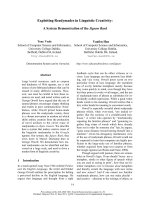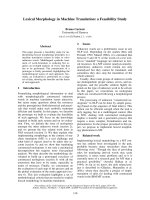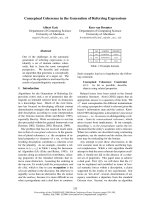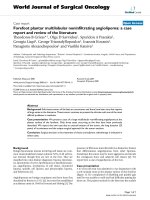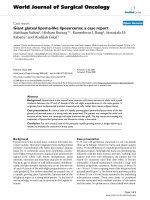báo cáo khoa học: " “Bong lung” in cystic fibrosis: a case report" pot
Bạn đang xem bản rút gọn của tài liệu. Xem và tải ngay bản đầy đủ của tài liệu tại đây (406.14 KB, 3 trang )
CAS E REP O R T Open Access
“Bong lung” in cystic fibrosis: a case report
Zoe Gao
1
, Richard Wood-Baker
1
, Robin Harle
2
, Kon Muller
3
, Jenny Hauser
1
, David W Reid
1*
Abstract
Introduction: Marijuana or “bong” lung has been recently described. Subjects typically develop large peripheral
paraseptal lung bullae and are predisposed to spontaneous pneumothoraces. The underlying mechanism for bullae
formation is uncertain, but probably relates to direct lung toxicity and repeated barotrauma as the smoker
performs frequent valsalva manoeuvres in an attempt to derive a greater drug effect.
Case presentation: We describe a case of probable “bong lung” occurring in a 23-year-old Caucasian man with
cystic fibrosis who had a history of recurrent pneumothoraces and unusual findings on sputum cytology.
Conclusion: Our case highlights the importance of questioning young adult cystic fibrosis patients about illicit
drug use and the utility of sputum cytology and computed tomography scanning when patients present with
pneumothoraces and deteriorations in clinic al status.
Introduction
Marijuana smoking has recently been identified as a risk
factor for bullous lung disease and the occurrence of
recurrent pneumothoraces [1,2]. Upper lobe lung deposi-
tion of hot particulate matter following inhalation stimu-
lates an inflammatory response that is characterised by the
accumulation of carbon-laden alveolar macrophages (AM)
and polymorphonuclear cells (PMNs) in the airway lumen
and lung parenchyma [3]. Marijuana suppresses the ability
of AM to phagocytose pathogens with an increased risk of
airway infection and lung abscesses [ 4,5]. There are also
suggestions that marijua na smoking inc reases the risk of
lung cancer, although this is as yet not definitely esta b-
lished [6,7].
We describe the case of a 23-year-old Caucasian man
with cystic fibrosis (CF) with recurrent pneumothoraces,
which were most probably due to “bong lung” and the
presence of unusual findings on sputum cytology.
Case Presentation
A 23-year-old Caucasian man with CF was admitted with
a one-week history of pleuritic chest pain, increased cough
and sputum purulence, accompanied by some minor hae-
moptysis. Lung function had deteriora ted; FEV
1
of 2.01L
(42% predicted) compared to 2.76L (57% predicted) when
well . On examination, he was clubbed and malnourished
(body mass index: 18), but not cyanosed. Auscultation of
his chest revealed widespread inspiratory crackles o ver
both upper lobes. A diagnosis of an infective exacerbation
of his bronchiectasis was made. He was continued on
intravenous ceftazidime and tobramycin, regular phy-
siotherapy and nutritional supplementation.
Past medical history consisted of pancreatic insuffi-
ciency and chronic airway sepsis related to Ps eudomonas
aeruginosa infection. Diagnosis had be en made a t birth
and he possessed the ΔF508/1898 + G ® CF gene muta-
tion. He was known to have established osteoporosis and
significant ga stro-o esophageal reflux. Over the preceding
two years, he had been admitted to a hospital on 12 occa-
sions with acute exacerbations of his CF lung disease and
during this time period, his forced expiratory volume in
one second L (FEV
1
) had deteriorated from 3.17 L (74%
predicted) to 2.76L (57% pr edicted). He also had a past
history of recurrent left-sided pneumothoraces.
During th e admission, he developed spi king fevers and
complained of worsening pleuritic pain. A Computed
Tomograp hy (CT) pulmonary angiogram was performed
to look for pulmonary emboli. The CT scan showed no
emboli, but demonstrated large bilateral upper lobe lung
bullae, more prominent on the right side with characteris-
tic bronchiectatic changes elsew here (Figure 1). Sputum
microscopy revealed the expected predominance of
PMNs, but also droplets of oily brown material embedded
in mucus. PMNs were observed containing vacuoles full of
* Correspondence:
1
Departments of Respiratory Medicine, Royal Hobart Hospital, Liverpool
Street, Hobart, Tasmania, 7000, Australia
Full list of author information is available at the end of the article
Gao et al. Journal of Medical Case Reports 2010, 4:371
/>JOURNAL OF MEDICAL
CASE REPORTS
© 2010 Gao et al; licensee BioMed Central Ltd. This is an Open Access article distributed under the terms of the Creative Commons
Attribution License ( which permits unrestricted use, di stribution, and reproduction in
any medium, provided the original wor k is properly cited.
this brown-pigmented substance and elsewhere, these
droplets could be seen su rrounded by palisades of PMNs
(Figure 2). On closer questioning, the patient admitted to
several years of marijuana smoking through a bong. He
denied use of tobacco. A provisional diagnosis of “ bong
lung” complica ting severe CF bronchiectasis was made.
The patient made a slow recovery over three weeks and
received counselling about his marijuana use. He was dis-
charged with an FEV
1
of 2.33L (48% predicted).
Discussion
Marijuana lung has been described in habitual smokers,
but not previously in the setting of CF. Our patient pre-
sented with frequent exacerbations on the background
of recurrent spontaneous pneumothoraces and a rapid
deterioration in lung function. He was found to have
large apical bullae on high-resolution computerized
tomography (HRCT) scanning, similar to those typically
observed in marijuana smokers. To the best of our
knowledge, this is the first reported case of bong lung in
CF, but the prevalence of marijuana use in CF has been
reported to be as high as 20% suggesting this may be a
potentially under-diagnosed condition [8]. Bong lung is
worth considering in CF adults, especially as pneu-
mothorax is such a relatively common complication of
the disease with three quarters of cases occurring in
patients aged over 18 years old [9].
Our case was particularly notable for th e novel appear-
ances on sputum microscopy of palisades of PMNs sur-
rounding and trying to engulf/phago cytose droplets of
marijuana. There have been no previous reports of airway
PMNs containing unusual inclusion bodies in marijuana
smokers, but enhanced PMN recruitment and activation
in CF related to marijuana inhalation may exacerbate the
already over-exuberant innate immune response and pro-
mote further lung injury.
Conclusion
Our case highlights the importance of considering drug
abuse/marijuana use in CF patients, particularly in the
context of atypical paraseptal bullae, recurrent pneu-
mothoraces, accelerated decline in lung function and
repeated admissions with increasi ng airway sepsis. Con-
sideration should be given to sputum cytology and CT
scanning when CF patients develop an unexplained
deterioration in respiratory status.
Consent
Written informed consent was obtained from the patient
for publicatio n of this case report and any accompany-
ing images. A copy of the written consent is available
for review by the Editor-in-Chief of this journal.
Abbreviations
AM: alveolar macrophages; CF: cystic fibrosis; CT: Computed Tomography:
FEV
1
:forced expiratory volume in 1 second L; HRCT: High Resolution
Computed Tomography; PMNs: polymorphonuclear cells.
Author details
1
Departments of Respiratory Medicine, Royal Hobart Hospital, Liverpool
Street, Hobart, Tasmania, 7000, Australia.
2
Radiology, Royal Hobart Hospital,
Liverpool Street, Hobart, Tasmania, 7000, Australia.
3
Discipline of Pathology,
Figure 1 High resolution CT scan of the patient’ s lungs
demonstrating apical bullae. Note the prominent bronchial
arteries (arrow).
Figure 2 Sputum cytology using Giemsa stain (x100
magnification and oil immersion lens). Note the brown oily
material (arrows) and surrounding PMNs.
Gao et al. Journal of Medical Case Reports 2010, 4:371
/>Page 2 of 3
University of Tasmania Medical School, Collins Street, Hobart, Tasmania, 7000,
Australia.
Authors’ contributions
DR was the consultant physician caring for the patient at the time of
presentation and diagnosis, and ZG was a medical student attached to the
respiratory unit at the time. ZG identified the uniqueness of the case and
wrote the first draft of the case report. DR contributed to the writing of the
case report as did his colleagues RWB, KM and RH. KM was responsible for
interpretation of the sputum cytology and RH interpreted the radiology. JH
elucidated the history of substance abuse and contributed to the review of
the manuscript. All authors have read and approved the final manuscript.
Competing interests
The authors declare that they have no competing interests.
Received: 21 October 2009 Accepted: 19 November 2010
Published: 19 November 2010
References
1. Hii SW, Tam JD, Thompson BR, Naughton MT: Bullous lung disease due to
marijuana. Respirology 2008, 13:122-127.
2. Hii S, Naughton MT, Young A: Marijuana lung. Intern Med J 2006,
36:270-271.
3. Tashkin DP: Smoked marijuana as a cause of lung injury. Monaldi Arch
Chest Dis 2005, 63:93-100.
4. Hamadeh R, Ardehali A, Locksley RM, York MK: Fatal aspergillosis:
associated with smoking contaminated marijuana, in a marrow
transplant recipient. Chest 1988, 94:432-433.
5. Mann PE, Cohen AB, Finley TN, Ladman AJ: Alveolar macrophages.
Structural and functional differences between nonsmokers and smokers
of marijuana and tobacco. Lab Invest 1971, 25:111-120.
6. Sewell RA, Cohn AJ, Chawarski MC: Doubts about the role of cannabis in
causing lung cancer. Eur Respir J 2008, 32:815-816.
7. Aldington S, Harwood M, Cox B, Weatherall M, Beckert L, Hansell A,
Pritchard A, Robinson G, Beasley R: Cannabis use and risk of lung cancer:
a case-control study. Eur Respir J 2008, 31:280-286.
8. Stern RC, Byard PJ, Tomashefski JF Jr, Doershuk CF: Recreational use of :
psychoactive drugs by patients with cystic fibrosis. J Pediatr 1987,
111:293-299.
9. Stenbit A, Flume PA: Pulmonary complications in adult patients with
cystic fibrosis. Am J Med Sci 2008, 335:55-59.
doi:10.1186/1752-1947-4-371
Cite this article as: Gao et al.: “Bong lung” in cystic fibrosis: a case
report. Journal of Medical Case Reports 2010 4:371.
Submit your next manuscript to BioMed Central
and take full advantage of:
• Convenient online submission
• Thorough peer review
• No space constraints or color figure charges
• Immediate publication on acceptance
• Inclusion in PubMed, CAS, Scopus and Google Scholar
• Research which is freely available for redistribution
Submit your manuscript at
www.biomedcentral.com/submit
Gao et al. Journal of Medical Case Reports 2010, 4:371
/>Page 3 of 3

